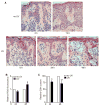Use of oral N-acetylcysteine for protection of melanocytic nevi against UV-induced oxidative stress: towards a novel paradigm for melanoma chemoprevention
- PMID: 19920101
- PMCID: PMC2787788
- DOI: 10.1158/1078-0432.CCR-09-1890
Use of oral N-acetylcysteine for protection of melanocytic nevi against UV-induced oxidative stress: towards a novel paradigm for melanoma chemoprevention
Abstract
Purpose: Induction of oxidative stress has been implicated in UV-induced melanoma. We sought to determine whether the antioxidant N-acetylcysteine (NAC) could be safely administered to protect melanocytic nevi from the oxidative stress resulting from acute UV exposure.
Experimental design: Patients at increased risk for melanoma were recruited from a screening clinic. Induction and detection of oxidative stress (reactive oxygen species and glutathione depletion) was optimized in nevi following ex vivo UV irradiation. Nevi were removed from patients before, and following, oral ingestion of a single (1,200 mg) dose of NAC, and then these nevi were UV irradiated (4,000 J/m(2)).
Results: Oxidative stress was induced in nevi 24 to 48 hours following ex vivo UV irradiation. A single oral dose of NAC was well tolerated in all patients (n = 72). Basal levels of reduced glutathione and the NAC metabolite cysteine were well correlated between similar-appearing nevi from the same patient and were significantly increased in nevi removed 3 hours after NAC ingestion compared with nevi removed before drug ingestion. In approximately half (9 of 19) of patients tested, UV-induced glutathione depletion was attenuated in the postdrug (compared with predrug) nevus.
Conclusions: NAC can be safely administered to patients for the purpose of modulating UV-induced oxidative stress in nevi. This study suggests the feasibility of patients taking NAC prophylactically before acute UV exposure, to prevent pro-oncogenic oxidative stress in nevi and ultimately reduce long-term melanoma risk.
Conflict of interest statement
Conflicts of interest: None declared.
Figures



Similar articles
-
A Phase II Randomized Placebo-Controlled Trial of Oral N-acetylcysteine for Protection of Melanocytic Nevi against UV-Induced Oxidative Stress In Vivo.Cancer Prev Res (Phila). 2017 Jan;10(1):36-44. doi: 10.1158/1940-6207.CAPR-16-0162. Epub 2016 Dec 5. Cancer Prev Res (Phila). 2017. PMID: 27920018 Free PMC article. Clinical Trial.
-
N-acetylcysteine protects melanocytes against oxidative stress/damage and delays onset of ultraviolet-induced melanoma in mice.Clin Cancer Res. 2007 Oct 1;13(19):5952-8. doi: 10.1158/1078-0432.CCR-07-1187. Clin Cancer Res. 2007. PMID: 17908992 Free PMC article.
-
A Randomized Double-blind Placebo-controlled Trial of Oral Aspirin for Protection of Melanocytic Nevi Against UV-induced DNA Damage.Cancer Prev Res (Phila). 2022 Feb;15(2):129-138. doi: 10.1158/1940-6207.CAPR-21-0399. Epub 2021 Nov 8. Cancer Prev Res (Phila). 2022. PMID: 34750146 Free PMC article. Clinical Trial.
-
Black and Brown Oro-facial Mucocutaneous Neoplasms.Head Neck Pathol. 2019 Mar;13(1):56-70. doi: 10.1007/s12105-019-01008-2. Epub 2019 Jan 29. Head Neck Pathol. 2019. PMID: 30693458 Free PMC article. Review.
-
Pediatric melanoma, moles, and sun safety.Pediatr Clin North Am. 2014 Apr;61(2):279-91. doi: 10.1016/j.pcl.2013.11.004. Epub 2014 Jan 28. Pediatr Clin North Am. 2014. PMID: 24636646 Review.
Cited by
-
Oxidative State in Cutaneous Melanoma Progression: A Question of Balance.Antioxidants (Basel). 2024 Aug 30;13(9):1058. doi: 10.3390/antiox13091058. Antioxidants (Basel). 2024. PMID: 39334716 Free PMC article. Review.
-
Chemoprevention agents for melanoma: A path forward into phase 3 clinical trials.Cancer. 2019 Jan 1;125(1):18-44. doi: 10.1002/cncr.31719. Epub 2018 Oct 3. Cancer. 2019. PMID: 30281145 Free PMC article. Review.
-
Mitochondrial oxidative stress drives tumor progression and metastasis: should we use antioxidants as a key component of cancer treatment and prevention?BMC Med. 2011 May 23;9:62. doi: 10.1186/1741-7015-9-62. BMC Med. 2011. PMID: 21605374 Free PMC article.
-
Glucose availability controls ATF4-mediated MITF suppression to drive melanoma cell growth.Oncotarget. 2017 May 16;8(20):32946-32959. doi: 10.18632/oncotarget.16514. Oncotarget. 2017. PMID: 28380427 Free PMC article.
-
Potent antioxidative and UVB protective effect of water extract of Eclipta prostrata L.ScientificWorldJournal. 2014 Feb 9;2014:759039. doi: 10.1155/2014/759039. eCollection 2014. ScientificWorldJournal. 2014. PMID: 24683358 Free PMC article.
References
-
- Tsao H, Atkins MB, Sober AJ. Management of cutaneous melanoma. N Engl J Med. 2004;351:998–1012. - PubMed
-
- Crucioli V, Stilwell J. The histogenesis of malignant melanoma in relation to pre-existing pigmented lesions. J Cutan Pathol. 1982;9:396–404. - PubMed
-
- Robinson WA, et al. Human acquired nevi are clonal. Melanoma Res. 1998;8:499–503. - PubMed
-
- Kelly JW, et al. Sunlight: a major factor associated with the development of melanocytic nevi in Australian schoolchildren. J Am Acad Dermatol. 1994;30:40–8. - PubMed
-
- Gilchrest BA, Eller MS, Geller AC, Yaar M. The pathogenesis of melanoma induced by ultraviolet radiation. N Engl J Med. 1999;340:1341–48. - PubMed
Publication types
MeSH terms
Substances
Grants and funding
LinkOut - more resources
Full Text Sources
Other Literature Sources
Medical

